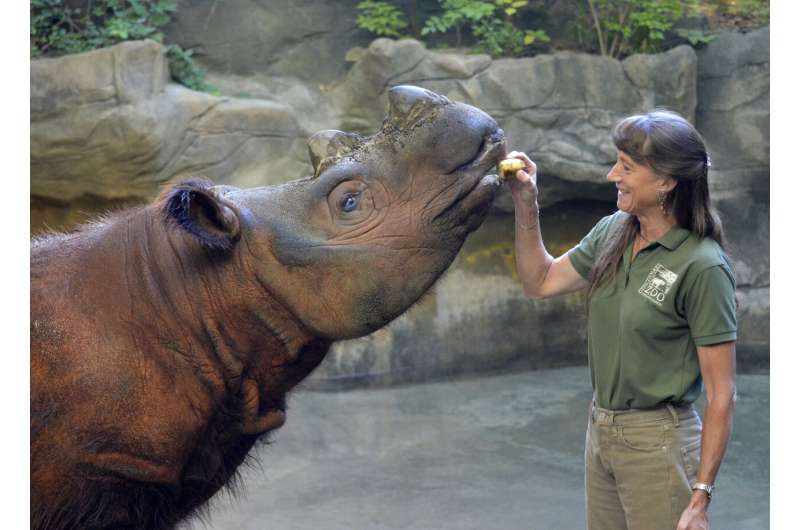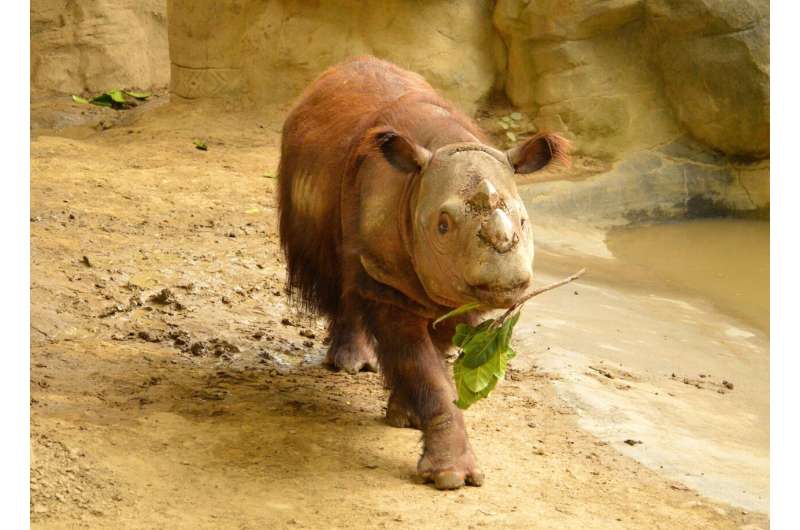Terri Roth, director of the Cincinnati Zoo & Botanical Garden's Center for Conservation and Research of Endangered Wildlife, is helping Indonesia boost the number of endangered Sumatran rhinos. Credit: Cincinnati Zoo & Botanical Garden
A University of Cincinnati adjunct professor flew to Indonesia this year to visit some old friends, Harapan and Andalas.
They are Sumatran rhinos born at the Cincinnati Zoo & Botanical Garden and repatriated back to Indonesia to be part of a managed breeding program. The rhinos are on the very brink of extinction with just 80 surviving individuals. Only six have been born under managed care. The future of the species is uncertain.
Terri Roth, an adjunct professor of biology at UC and the Cincinnati zoo's vice president for conservation and science, helped the nonprofit institution successfully produce three babies. As director of the zoo's Center for Conservation and Research of Endangered Wildlife or CREW, she is sharing the zoo's collective knowledge with the team of experts at the Sumatran Rhino Sanctuary in Way Kambas National Park, Indonesia.
"I have great confidence in the team working there," Roth said. "They have adopted all the practices we developed at the Cincinnati Zoo. They are producing calves, so fingers crossed."
Roth's position with UC is just one of several connections between the research university and the zoo named the best in North America in 2022 by U.S. Today. UC students and faculty have collaborated with the Cincinnati Zoo on a variety of projects in veterinary research, animal behavior and physiology, engineering and enrichment.
"It's been a great relationship between UC and CREW," Roth said.
These collaborations are having a real-world impact on wildlife around the world. Time is not on their side. Rhinos are in trouble almost everywhere they are found. Poaching wiped out the northern white rhino and the black rhino in many parts of Africa. The Javan rhino is nearly extinct.
The Cincinnati Zoo & Botanical Garden in 2015 repatriated Harapan, the last Sumatran rhino in the Western Hemisphere, to a reserve in Indonesia. Credit: Michael Miller
Roth organized a coalition of rhino experts to ensure the well-being of rhinos with the goal to improve their health, fitness and reproductive success. So far, almost 50 zoos across North America have joined Roth's coalition, the American Institute of Rhinoceros Science.
The Cincinnati Zoo's logo features a black rhino. Its newest addition, Ajani Joe, was born in 2020.
The rapid decline of Sumatran and Javan rhinos showed how quickly species can go extinct. Roth said she is hoping the combined rhino expertise she is helping to assemble will provide a safety net both for animals living in the wild and in zoos.
Rhinos in some places are poached for the keratin in their horns, which has no medicinal value but is sold as a cure-all by criminal wildlife traffickers. The illicit sale of rhino horn generated more than $170 million between 2016 and 2018, according to the U.S. Fish and Wildlife Service.
"Elephants might raid crops, and tigers can kill people. But the rhino doesn't do any of that," she said. "I often ask, "What does it say about humanity if we can't share the planet with a species that is not a threat to us or our food and is just living its life?'"
Some rhinos are susceptible to having an overabundance of iron in their organs that can cause damage, dysfunction or even death. Roth said iron storage could be an evolutionary adaptation to blood-sucking parasites like ticks and mosquitoes that inexorably drain a rhino's blood through thousands of tiny bites. Because rhinos in zoos are spared from these pests, they conserve more iron than they might in the wild.
"Working on the Sumatran rhino project was a huge privilege. I feel very fortunate to be at a zoo with a facility committed to conservation research," Roth said.
"We can hope they make a big comeback," Roth said.
Provided by University of Cincinnati

























